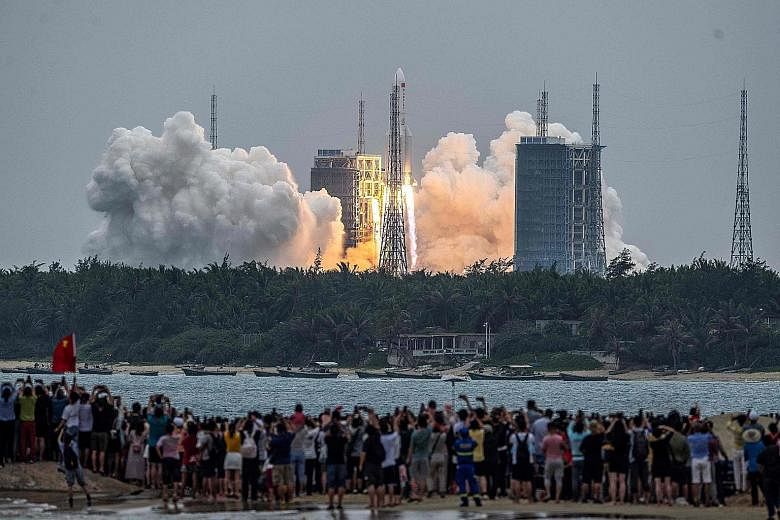BEIJING • China launched the first module of its "Heavenly Palace" space station yesterday, a milestone in its ambitious plan to establish a permanent human presence in space.
Billions of dollars have been poured into space exploration as China seeks to reflect its rising global stature and growing technological might, following in the footsteps of the United States, Russia and Europe.
The Tianhe core module, which houses life support equipment and a living space for astronauts, was launched from Wenchang in China's tropical Hainan province on a Long March 5B rocket, state television showed.
President Xi Jinping called the space station a key step in "building a great nation of science and technology" in a congratulatory message.
The Tiangong space station, whose name means "Heavenly Palace", is expected to be operational by next year after around 11 missions to deliver more modules and assemble them in orbit.
Live footage from broadcaster CCTV showed space programme employees cheering as the rocket - billowing flames - powered its way through the atmosphere from the launch site.
Photos published by the China Aerospace Science and Technology Corporation show crowds wearing sunhats and wielding smartphone cameras gathered under the coconut trees of a nearby beach to watch the launch as a band played.
"A palace in the sky will no longer be just a romantic fantasy of the ancients," the CCTV anchor said.
The completed station will be similar to the Soviet "Mir" one that orbited Earth from the 1980s until 2001.
Tiangong is expected to remain in low orbit at between 400km and 450km above Earth for a lifespan of around 15 years.
The completed station, weighing little more than 90 tonnes, will be around a quarter the size of the International Space Station (ISS).
Tiangong will have two other modules for scientific study and be equipped with solar panels and equipment, including an ultra-cold atomic experiment apparatus, according to the Chinese Society of Astronautics.
The core module will give three astronauts 50 cu m of living space, equipped with advanced telecommunications equipment that will allow them to browse websites "no differently from normal people using the Internet and phones on Earth", Mr Bai Linhou, deputy chief designer of the space station, told CCTV.
China launched the Tiangong 1 lab, its first prototype module intended to lay the groundwork for the permanently crewed station, in September 2011.
The lab disintegrated on re-entry into the Earth's atmosphere in 2018, two years after it ceased functioning. A second lab, the Tiangong 2, was launched in 2016.
The ISS - a collaboration involving the US, Russia, Canada, Europe and Japan - is due to be retired after 2024, although America's National Aeronautics and Space Administration has said it could potentially remain functional beyond 2028.
With the retirement of the ISS, which received its first crew in 2000, Tiangong could become the only space station in Earth's orbit.
Beijing does not have specific plans to use its space station for international cooperation like the ISS. However, the Chinese space authorities have said that they are open to foreign collaboration, although the scope of that tie-up is as yet unclear.
The European Space Agency has sent astronauts to China to receive training in order to be ready to work inside the Chinese space station once it is launched.
Beijing also said last month that it was planning to build a separate lunar space station with Russia.
The facility, planned for either the surface or the orbit of the Moon, would house research facilities and would be China's biggest international space cooperation project to date.
The country has come a long way since it launched its first satellite in 1970.
It put the first Chinese "taikonaut" in space in 2003 and landed the Chang'e 4 robot on the far side of the Moon in 2019 - a historic first.
The Chinese space programme sent a probe into Mars' orbit earlier this year. The wheeled probe is expected to touch down on the surface of that planet in the middle of next month.
AGENCE FRANCE-PRESSE

